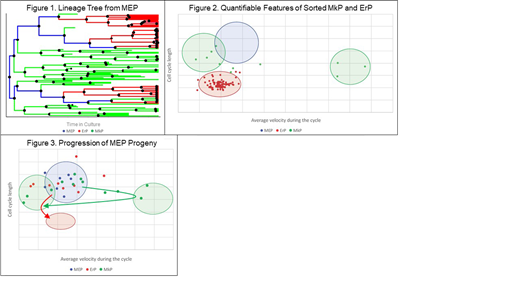The molecular mechanisms underlying lineage commitment of stem and progenitor cells have implications for deriving specific cell types in vitro for regenerative medicine purposes and elucidating the aberrant pathways responsible for pathological conditions. We investigated Megakaryocytic-Erythroid Progenitors (MEP) commitment to the megakaryocytic (Mk) and erythroid (E) lineages as a model of cell fate decisions.
Colony forming unit (CFU) assays are used to test the functional output, or lineage potential, of progenitor cell populations. As single progenitor cells proliferate, their progeny remain near each other to form a colony. This potential is deduced from the mature cell types comprising the colony. However, this assay has several limitations: 1) there is an assumption that each colony arose from a single progenitor cell based on the low probability that individual progenitors would form overlapping colonies when plated sparsely; 2) there is a surfeit of kinetic data about the colony forming cells that is not collected with a single end-point; and 3) the outcome may be misleading if there is selective loss of specific cell types of early committed progeny prior to the endpoint.
To overcome these limitations, we developed a time-lapse microscopy and lineage tracing approach to visualize single sorted MEP, as well as committed Megakaryocytic progenitors (MkP) and Erythroid progenitors (ErP), as they proliferate, specify and progress down either the Mk or E lineages. We plated primary adult human MEP (Sanada and Xavier-Ferrucio, et al. Blood, 2016) at low density in semisolid media supplemented with cytokines in a MatTek plate under a coverslip to minimize focal range and support colony formation for up to 14 days. The plated cells were imaged with an Olympus VivaView. Fluorescently conjugated anti-CD41 (a marker of Mk) and anti-CD235a (a marker of E) were added to the culture dishes at the end to confirm the lineage of each cell in the colonies.
The average time from plating to the first division was 38 h, and not significantly different between MEP, ErP, and MkP. We optimized the image acquisition settings to permit accurate tracking of the plated cells and their progeny for up to 11 days. Average colony forming efficiency was 75%, which was equal to unimaged CFU assays, indicating minimal phototoxicity. Acquired images were stacked into time-lapse videos and automatically tracked with the Baxter Algorithm (Magnusson et al. IEEE Trans Med Imaging, 2015). After manual segmentation and track correction, lineage trees were generated for each colony (Figure 1). We exported quantifiable features of the cells including the time between cell divisions and velocity of each cell from the algorithm. We defined cells that give rise to only CD41-labeled cells as committed MkP, cells that give rise to only CD235-labeled cells as ErP, and cells that give rise to at least one progeny of both as MEP. However, these progenitor definitions are based on an inaccurate assumption that fate reflects potential, since a bipotent cell may stochastically give rise to progeny that are committed to a single lineage.
To convert fate to potential, we first need to identify the precise period of commitment to more accurately define MEP, MkP, and ErP in our culture system. To achieve this, we are developing a mathematical model that can predict the potential of cells based on quantifiable features that are measured form the time-lapse images and are significantly different between MEP, MkP, and ErP. Utilizing statistical tools, we have identified that the duration of the cell cycle and the velocity of single progenitor cells along with their lineage history, permit predictions of progenitor potential and provide several novel insights into the process of lineage commitment. We found that ErP have a significantly shortened cell cycle duration and slower velocity compared to MkP, while MEP have the longest cell cycle and an intermediate velocity until undergoing their fate decisions (Figures 2 and 3). With this time-lapse imaging approach, we hope to better investigate molecular mechanisms that direct fate decisions of multipotent progenitor cells.
No relevant conflicts of interest to declare.
Author notes
Asterisk with author names denotes non-ASH members.


This feature is available to Subscribers Only
Sign In or Create an Account Close Modal